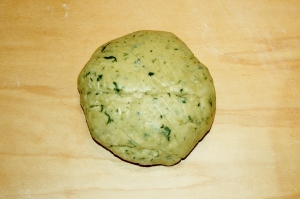For the filling;
5 ounces very coarsely chopped lobster meat
5 ounces very coarsely chopped shrimp meat (also half cooked)
6 ounces ricotta cheese
1 tablespoon dried tarragon
½ tsp salt
For the Pasta;
2-1/3 cups unbleached flour plus ¼ cup or more for dusting and to adjust pasta wetness
1/2 teaspoons salt
¾ oz tarragon stems removed, chopped
3 large eggs slightly beaten
In a food processor combine the eggs, flour, the salt and the tarragon. Pulse a few times to combine the mixture. Add the flour and half the water and process the mixture until it comes together in a ball. Add a tablespoon of water at a time if the dough does not come together. Remove the dough from the food processor, wrap in plastic wrap, and let it rest at room temperature for one hour.
Knead the dough with the heels and palms of your hands to make sure it is not too sticky or dry. Divide the dough into four pieces. Set your pasta roller on the highest setting and roll your pasta through it twice, after sending it through the first time, fold it over onto itself, rotate it 90° and send it through again. Skip a notch and send the dough through the rollers again. Repeat the process three times, skipping a notch each time. I usually don’t go much thinner as the pasta sheets will tear when filling. If your dough gets too long cut it in half and repeat for both pieces. Cover your dough with a kitchen towel and repeat the procedure the remaining three pieces of dough.
Combine the filling ingredients and taste for seasoning. Add salt and pepper as necessary. Lay two sheets of the pasta dough out side-by-side, and depending on whether you use a press, a roller or just freehand, gently fill one side of the pasta with a tablespoon size portion of the filling. (You can see in the pictures that I used three different methods for creating the ravioli.) Using an egg white beat together with water; use your finger or a brush to paint the perimeter of each ravioli. Next, very gently, lay the top half of the pasta on top of the filled half. At this point if you are making raviolis freehand, you will want to cut each ravioli individually then, force all the air out and seal it tight. Be careful not to overstretch the sheets when you seal them, or they will tear when they go into the boiling
Drop a few at a time into a large pot of gently boiling salted water. Raviolis are done when they float to the surface about 1 to 2 minutes max. Serve with your favorite red sauce, tarragon beurre blanc or just a butter/white wine/lemon and garlic sauce.


